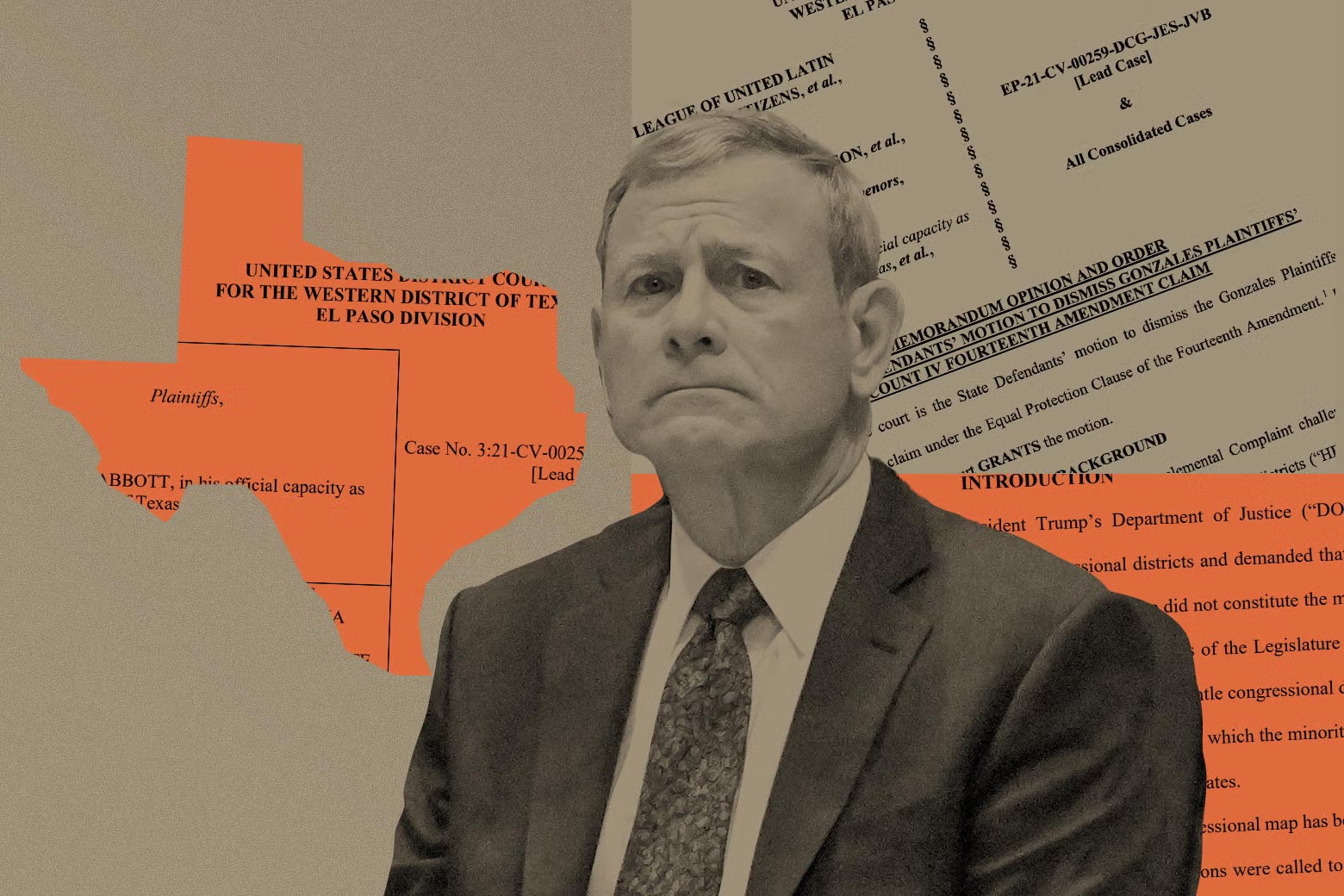Trump’s Scheme to Gift the GOP Extra House Seats Just Blew Up in His Face

Sign up for the Slatest to get the most insightful analysis, criticism, and advice out there, delivered to your inbox daily.
A federal court struck down Texas’ new gerrymander on Tuesday, in an extraordinary rebuke to Republicans who sought to hand the GOP five additional seats in the House of Representatives. The 160-page ruling—authored by Judge Jeffrey V. Brown, a conservative Donald Trump nominee—scorched the scheme as an unconstitutional racial gerrymander, declaring that the Legislature “intentionally drew district lines” to discriminate against Black and Hispanic Texans.
Remarkably, Brown found that it was Trump’s own Department of Justice that had injected race into the plot as part of its “hamfisted” effort to cook up a pretext for new maps. And he laid out a gobsmacking amount of smoking-gun evidence that all points in the direction of unlawful racism. The Texas Legislature, Brown noted, could simply have drawn a straightforward partisan gerrymander that benefited Republicans without regard to race. Instead, it colluded with the DOJ to reengineer congressional districts by skin color—the one thing that even this Supreme Court does not allow.
Tuesday’s decision in LULAC v. Abbott revolves around the Trump administration’s push for middecade redistricting to bolster the GOP’s advantage in the House. The president himself reportedly urged the Lone Star State to create a map that would secure at least five more House seats for the party in the 2026 midterms. Many Texas Republicans were initially resistant to Trump’s call, including Gov. Greg Abbott, wary of the backlash that a nakedly partisan gerrymander might provoke. Then, on July 7, Harmeet Dhillon, the head of the DOJ’s Civil Rights Division, sent the governor a letter claiming that Texas’ current congressional districts were unconstitutionally racist. She threatened to sue if those districts were not redrawn, creating an ostensibly nonpartisan excuse for new maps. Two days later, Abbott cited Dhillon’s letter as a reason to push forward with redistricting and called a special session to ram through a new gerrymander. Democratic Texas legislators fled the state in a last-ditch bid to thwart the plan, but Republicans flexed their legislative majority to push the map past the finish line.
In response, a coalition of voting rights advocates sought an injunction against the gerrymander. They argued that it intentionally discriminated on the basis of race in clear violation of the 14th and 15th amendments. Due to a quirk in federal law, the case went to a three-judge district court made up of Brown (the Trump appointee), David C. Guaderrama (a Barack Obama appointee), and Jerry Smith (a Ronald Reagan appointee). By a 2–1 vote, the court sided with the plaintiffs, over Smith’s dissent (which has not yet been published).
It is fairly astonishing that Brown authored the decision, given that he is a hard-right Federalist Society stalwart best known for issuing a nationwide injunction against one of President Joe Biden’s COVID vaccine mandates. What’s more damning, though, is that Brown largely blames Dhillon and her deputies at the DOJ for bungling the whole gambit. Partisan gerrymandering, he noted, is permissible under the U.S. Constitution. And “to be sure, politics played a role” in the creation of this map. But Texas Republicans repeatedly disclaimed that they were, first and foremost, attempting to comply with Dhillon’s demands. And her primary demand was that they re-sort voters along racial lines.
Why? That is the baffling question that Brown spent much of his opinion trying to resolve. Here is what appears to have happened: Texas Republicans wanted a pretext they could use as a fig leaf to pretend that their gerrymander was not purely partisan. Dhillon was well positioned to concoct one, since she could threaten to sue the state if it didn’t follow through on Trump’s demands. Her solution was to seize upon a recent ruling by the U.S. Court of Appeals for the 5th Circuit, Petteway v. Galveston County, which held that the Voting Rights Act does not require states to draw multiracial “coalition” districts. (In other words, Texas does not have to combine two minority groups to create one majority-minority district.) Petteway merely relieved states of the obligation to draw coalition districts. In her letter, though, Dhillon twisted the ruling into a prohibition against these districts. Because Texas currently has a number of them, she wrote, the state’s congressional map was unconstitutional and had to be retooled.
Dahlia Lithwick and Mark Joseph Stern
Why It Matters That Trump’s DOJ Got Caught by a Judge Blatantly Lying—Again
Read More
As Brown noted on Tuesday, it is “challenging to unpack the DOJ Letter because it contains so many factual, legal, and typographical errors.” Even the Texas Attorney General’s Office—a “political ally of the Trump administration”—dismissed Dhillon’s reasoning as “legally unsound,” “baseless,” and “a mess.” That is because her main argument is objectively false: The 5th Circuit did not outlaw existing coalition districts, or even bar their creation in the future. It merely held that states have no affirmative obligation to draw them under the VRA. Yet Republican legislators plowed ahead under Dhillon’s theory anyway, with the blessing of the state’s attorney general and governor, replacing the coalition districts with a more ruthless GOP gerrymander.
To do so—and following the logic of the Dhillon letter—Republicans targeted Texas’ nonwhite voters with almost surgical precision. They left majority-white districts largely intact, even those that leaned Democratic. But they obliterated majority-minority “coalition” districts through the classic technique of a brazen racial gerrymander. Legislators first carved out more Hispanic-heavy districts, which they hoped would tilt Republican after Trump’s gains with this group in 2024. They then scattered remaining minority populations, including many Black residents, into majority-white districts that leaned Republican to dilute their votes. The result was a wholesale sorting of nonwhite Texans along overt racial lines, all under the guise of complying with a 5th Circuit decision that actually warned against the use of race in redistricting.
Over and over again, Republicans openly acknowledged that they were shifting voters around on the basis of race. Brown packed his opinion with direct admissions from legislators, along with expert analysis showing that the redistricting process was “racially discriminatory” from start to finish. The upshot, he wrote, is a map tainted by “unconstitutional racial classifications” that deprives minority voters of their “constitutional right to participate in free and fair elections” under the 14th and 15th amendments. He therefore blocked its use in the 2026 elections, ordering the state to revert to its earlier, less gerrymandered map.
-
There’s a Surprise Controversial Character in the New Epstein Emails. I Talked to Him.
-
This Content is Available for Slate Plus members only
Why It Matters That Trump’s DOJ Got Caught by a Judge Blatantly Lying—Again
-
She Was Such a Good Bank Robber Even the FBI Admired Her. There’s Still One Thing About Her That No One Can Figure Out.
-
I Need to Talk About the Weirdest Part of Epstein’s Emails—Besides, Uh, the Obvious
It is hard to know what happens next. Texas can appeal directly to the Supreme Court and seek a stay of Brown’s order in the meantime. SCOTUS has, of course, been exceedingly hostile to the Voting Rights Act in recent years and may soon kneecap it yet again. But Tuesday’s decision is not rooted in the VRA; it is, rather, based on the simple principle that the Constitution does not permit invidious racial discrimination in congressional elections. The Supreme Court purports to agree with that principle (as Brown reminded readers by quoting Chief Justice John Roberts at the outset of his opinion). But its democracy jurisprudence is not exactly a model of consistency beyond the presumption that the GOP always wins. Moreover, the Republican-appointed justices insist that courts should not alter voting rules too close to elections, with Justice Brett Kavanaugh suggesting that nine months before a race is too soon. Texas could try to run out the clock till February, then claim it doesn’t have enough time to comply with Brown’s decision.
The stakes are certainly high. Trump’s push for five more seats in Texas has set off a nationwide gerrymandering battle, with more red states scrambling to redraw their districts and blue states responding in turn. (With no apparent irony, the Justice Department has sued to block California’s new map as … a racial gerrymander.) Politics aside, though, the reality is that Brown is right as a matter of law: What Texas did here is essentially the one thing that even this Supreme Court says states can’t do to gain an electoral advantage. Republicans broke the law to get those five seats. Such ill-gotten gains should not survive a brush with the Constitution.





